American Browning M1918 (BAR) light machine gun
The rights to manufacture Browning Automatic Rifle were acquired by Colt, however, the possibility of its release by other companies (Marlin-Rockwell, Winchester) remained. Production began in February 1918, but the combat experience of BAR in World War I did not go beyond military trials. Despite this, both the French and the British hurried to order a BAR. Under the apparent influence of this machine gun, the French created the Chatellerault machine gun.
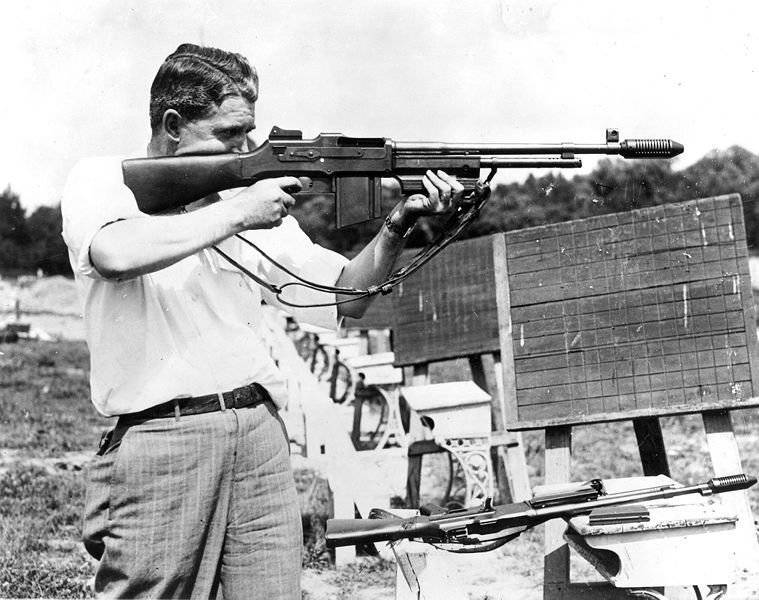
The basis of the design of the BAR machine gun went to the Vickers-Berthier system of the 1908 model of the year, which has an insignificant processing. The barrel in the receiver was fastened with a thread (this mount did not allow for the replacement of the barrel in combat conditions) and was supplied with a muzzle smooth sleeve “extension”. At first, five, and later four left-sided rifles were made in the barrel. The length of their stroke was 254 millimeters. Automation worked by withdrawing from the bore of the powder gases. Gas chamber - closed. A gas regulator having three holes was screwed in front of the guide tube. On the guide tube was attached antabka collar and a wooden forearm with a notch.
The barrel bore was locked by a lever hinged to the eyelet located in the middle part of the bolt. The bolt to the bolt carrier was fastened through a hinged earring. At the top of the milled receiver there was a ledge. A return spring was placed in the guide tube. The shutter during the movement of the moving system forward reached hemp stem and stopped. The slide frame, while continuing to move, turned the earring, while the back of the locking lever was raised. The support surface of the lever was driven behind the support surface of the protrusion of the receiver. After the shot, the bolt carrier moved back, lowered the lever and unlocked the barrel bore. The insert, located under the axis of the earring, prevented premature unlocking. He did not allow the locking lever and the earring to descend until the slide frame reaches the appropriate position. The liner was removed by a shutter ejector and a rigid reflector of the trigger box. The bolt carrier at the rearmost point hit the buffer. When firing, the charging handle remained stationary.
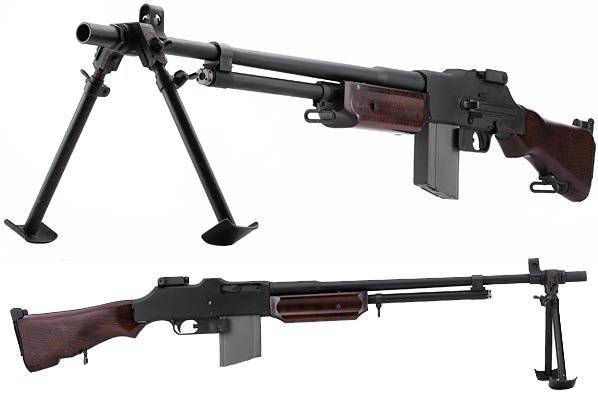
The trigger mechanism (USM) allowed the conduct of both single and continuous fire. The insert, after the barrel bore was locked, struck the drummer mounted in the bolt. The locking lever did not allow the drummer to move forward before locking, and when unlocking it was retracted. That is, the combination of the locking lever and the projection of the drummer played the role of an automatic fuse. USM, supplied with a buffer spring, mounted on the frame, which was located inside the trigger box. By pressing the trigger, the disconnector connected to it lifted the front end of the trigger lever, releasing the slide frame from the platoon.
The translator safety box was located behind the trigger guard on the left. In the forward position (“F”), the disconnector rose and jumped off the trigger. That, in turn, returned to its original position, intercepting the bolt carrier. If the flag was in a vertical position (“A”), the translator’s check was limited to turning the trigger lever in such a way that disconnection did not occur, and the automation cycle was repeated. If the flag was turned back (“S”), the trigger was blocked by a check.
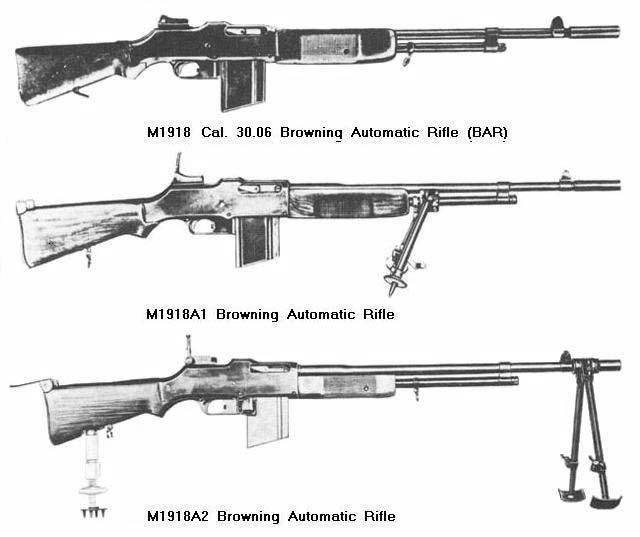
The folding frame sight was mounted on the receiver. The butt, which has a semi-protrusion protrusion, was put on the tail tube of the receiver and secured with a screw, reinforced by a metal nape. Antabka belt attached to it below.
Food was carried out from a two-row box store. The location of the cartridges - chess. The latch of the store was controlled with the help of a button, which was inserted inside the trigger guard. Thus, the shooter could squeeze the latch using the finger of a shooting hand to speed up the reloading. The machine gunner wore spare belt stores in canvas pouches. The BAR design consisted of 125 parts, 11 of which springs.
Winchester and Colt provided arms good finish, and its mass allowed to shoot in bursts with acceptable accuracy, but only with a stop. Fighting rate of fire in short bursts was 60 shots per minute, long - up to 180 shots per minute, provided that the stores were replaced quickly.
In 1922, the United States Cavalry adopted its own modification of the BAR model 1922 as a light machine gun, which fumbled without a pack. The barrel was weighted to 1575 grams and to the middle of the length provided with transverse fins. The frame sight, which has a mechanism for entering side corrections, was borrowed from the MNNX Browning machine gun. The bipods (weight 1919 kg) were fastened on the guide tube in front of the forearm, the legs in the fighting position were fixed with struts. In the recess of the butt was an additional folding support. Anknobs for the belt "thrown" on the left side is similar to a cavalry carbine. BAR model 1,42 released in small quantities.
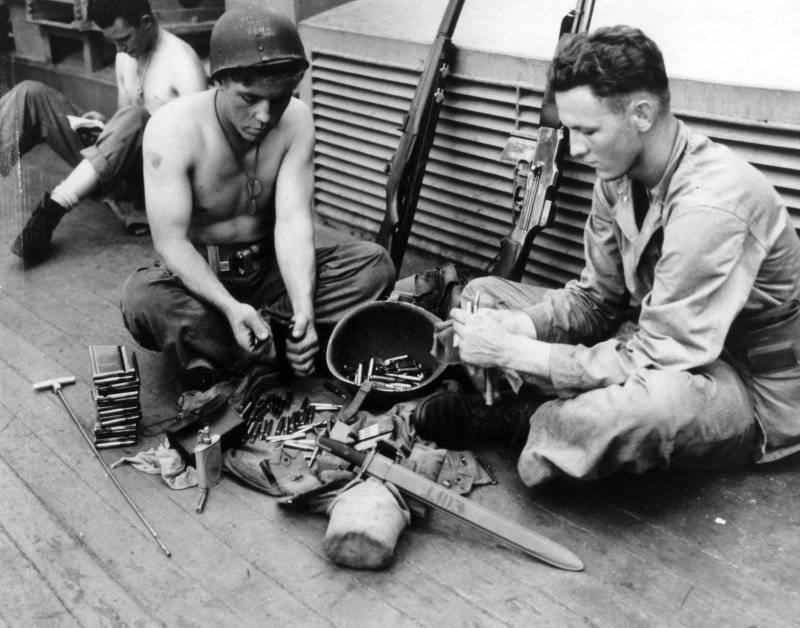
The US police used a self-loading version of the BAR Monitor.
In 1937, the army received the M1918A1 light machine gun, which was somewhat different from the M1918. Installed sight on the type of rifle "Enfield" M1917. In front of the forearm there were foldable bipods, folding humeral support - on the back of the butt. М1918А1 did not reach the level of the 1922 model, however, it was the 1922 model in 40 that was completely removed from service.
In 1941, before the entry of the United States into World War II, the substantially modernized BAR M1918A2 was adopted. Instead of continuous and single-fire modes, continuous-fire regimes were introduced at different rates — 300-450 shots per minute (F flag positions) and 500-550 per minute shots (A positions). To simplify work with the gas regulator head, it has been modified. Sight - type "Browning" M1919. A metal plate was mounted into the shortened handguard, protecting the return spring and handguard from overheating. Barrel equipped with a slotted flame arrester. Store guides were screwed to the trigger box, which reduced the risk of losing it. The shoulder support was shortened. In the butt there was an additional support, however, users almost immediately began to remove it (something similar happened with the applied support of the PD). Bipods were transferred to the muzzle of the trunk and supplied with wide shoes. For fixing screws with lambs were used. This position of the bipods limited the pickup sector and many machine gunners took them off, so over time the bipods were placed on the guide tube of the М1918А2 machine gun. In combat, machine gunners did not use humeral support either, so they were dismantled to facilitate the weapon.
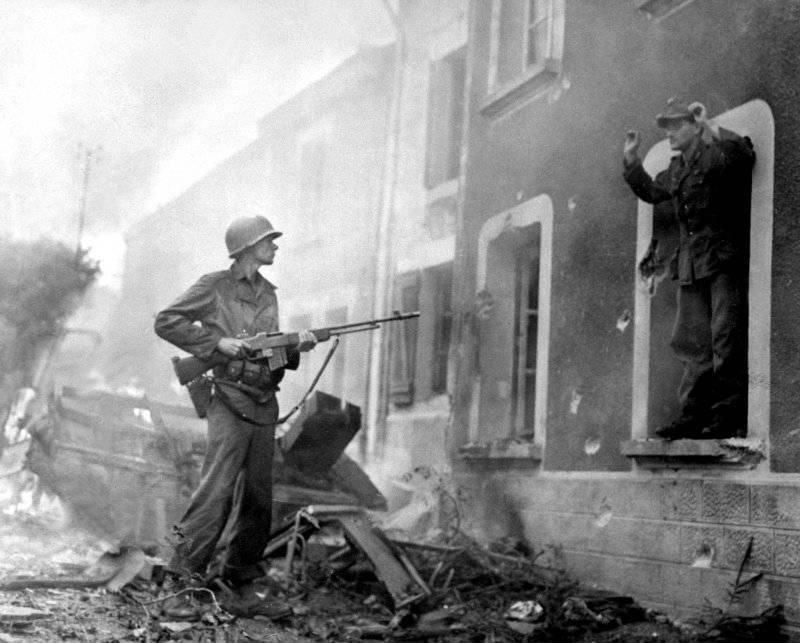
BAR to the beginning of the war was a weapon of separation and platoon. The Americans continued organizational experiments during World War II, but each time the BAR again became the core of small fire groups. However, with a relatively light non-replaceable barrel and limited magazine capacity, the machine gun could not provide long-term fire support. Even when firing in short bursts, visible flame and smoke were given by the overheated barrel. It can be assumed that the absence of a light machine gun that meets all the requirements forced the Americans to introduce soldiers, armed with combat shotguns, into the infantry regiments, which allowed them to conduct close combat in the undergrowth.
In addition to Marlin-Rockwell, Winchester Meeting Arms, and Colts Patent Firerms, BAR was engaged in the production of New England Arm Arms and IBM. The markings on the receiver included the inscription BROWNING BAR М1918 CAL 30 MFD BY (manufacturer's name).
BAR of early releases during the war returned to the factories to reach the level M1918А2. From the 42 of the year, a plastic butt was installed on the machine guns, which was reinforced with a metal bottom plate and a nape. In addition, there was a carrying handle. BAR from 1940 to 1941 years were delivered to the UK for local defense forces. The American marines preferred the M1918А2, which were altered in military workshops to give them a single fire regime. In general, due to the large number of alterations and "local upgrades" a lot of variations of BAR appeared.
The number of different models produced by BAR is estimated at 1 million, of which in the United States in 1922-1945 and more than 350 thousand machine guns of 1922, М1918А1 and М1918А2 models were produced during the Korean War. After a single NATO 7,62-mm cartridge (7,62x51) was adopted, the T34 machine gun was specially made for it, but this BAR option was only experienced. Although BAR М1918А2 was officially removed from service in 1957, it continued to serve later. Finally, the machine gun left the world stage only in the 80-s.
To unload the BAR you need to: unplug the magazine by pressing the magazine latch button located in front of the trigger guard. Take the loading handle back. Through the window of the receiver inspect the chamber. Return the handle to the forward position, pull the trigger.
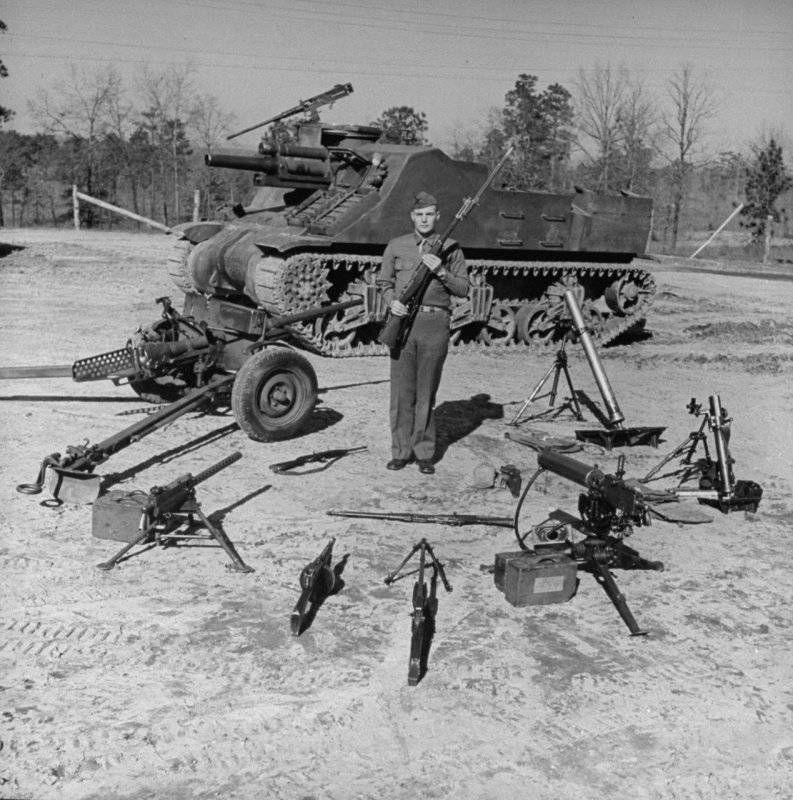
In the picture (counterclockwise):
1. Self-propelled howitzer NMS M7. Considering the combined nasal part (not solid) and the absence of flaps of the cabin, this cannot be a later model M7B1. The familiar name “Priest” is not appropriate, as it was used in the UK, not in the USA. On the turret - 12,7-mm (50-th caliber) Browning М2HB machine gun.
2. 37 mm gun M3.
3. Easel 7,62-mm (30 caliber) machine gun "Browning" М1919А4.
4. Submachine gun "Thompson" М1928А1.
5. M1918A2 Browning Automatic Rifle (BAR).
6. Browning М1917А1. Like the M1919, the machine gun caliber 7,62 mm.
7. 60-mm mortar M2.
8. 81-mm mortar M1.
In the inner circle - the M1 self-loading carbine, the Springfield M1903 rifle and the Colt M1911 A1 pistol; in the hands of a soldier - a Garand M1 self-loading rifle.
The order of incomplete disassembly BAR M1918A2:
1. Unload a machine gun.
2. Turn the contactor flag down, remove the contactor, separate the trigger box and the pistol grip.
3. Pull the charging handle back a little to align the axis of the earring and the hole in the receiver. Having pushed an axis, to separate the loading handle.
4. Remove the bolt carrier.
5. Remove the return spring rod.
6. Deselect the tube handler flag. Extract checkbox. Separate the tube with bipod.
7. Pull the slide frame forward.
8. Pull the latch to the left. Remove the bolt from the receiver.
The assembly was performed in the reverse order.
Technical characteristics of the main models of machine guns BAR:
Model - M1918;
Caliber - 7,62 mm;
Cartridge - .30-06
The mass of weapons - 7,26 kg (no magazine);
The mass of weapons - 7,805 kg (equipped with a magazine);
The length of the weapon is 1195 mm;
Barrel length - 610 mm;
The number of grooves - 5;
Initial bullet speed - 823 m / s;
Modes of fire - o / n;
The rate of fire - 600 shots per minute;
Combat rate - 40 / 180 shots per minute;
Sighting range - 1460 m;
Effective range - 600 m;
Magazine capacity - 20 cartridges.
Model - М198А1;
Caliber - 7,62 mm;
Chuck –.30-06
The mass of weapons - 8,41 kg (no magazine);
The mass of weapons - 8,965 kg (equipped with a magazine);
The length of the weapon is 1194 mm;
Barrel length - 600 mm;
The number of grooves - 4;
Initial bullet speed - 750 m / s;
Modes of fire - o / n;
The rate of fire - 400 shots per minute;
Combat rate - 40 / 180 shots per minute;
Sighting range - 1365 m;
Effective range - 600 m;
Magazine capacity - 20 cartridges.
Model - M1922;
Caliber - 7,62 mm;
Chuck –.30-06
The mass of weapons - 8,62 kg (no magazine);
The mass of weapons - 9,165 kg (equipped with a magazine);
The length of the weapon is 1194 mm;
Barrel length - 595 mm;
The number of grooves - 4;
Initial bullet speed - 735 m / s;
Modes of fire - o / n;
The rate of fire - 600 shots per minute;
Combat rate - 40 / 180 shots per minute;
Aim range - 91-1365 m;
Effective range - 600 m;
Magazine capacity - 20 cartridges.
Model - М1918А2;
Caliber - 7,62 mm;
Chuck –.30-06
The mass of weapons - 8,82 kg (no magazine);
The mass of weapons - 9,365 kg (equipped with a magazine);
The length of the weapon is 1219 mm;
Barrel length - 610 mm;
The number of grooves - 4;
Initial bullet speed - 855 m / s;
Modes of fire - n;
The rate of fire - 350-500 shots per minute;
Combat rate - 180 shots per minute;
Sighting range - 1372 m;
Effective range - 600 m;
Magazine capacity - 20 cartridges.
Model - M1924;
Caliber - 7,62 mm;
Chuck –.30-06 (М1, М2)
The mass of weapons with a long heavy barrel - 8,5 kg (no magazine);
The mass of weapons with a shortened barrel - 7,12 kg (without a magazine);
The mass of weapons with a long heavy barrel - 9,045 kg (with a loaded magazine) ;;
The weight of the weapon with a shortened barrel - 7,665 kg (with a loaded magazine) ;;
The length of the weapon is 1112 mm;
The length of the heavy barrel - 607 mm;
The length of the shortened trunk - 457 mm;
Modes of fire - o / n;
The rate of fire - 600 shots per minute;
Combat rate - 40 / 180 shots per minute;
Aim range - 200-1600 m;
Magazine capacity - 20 cartridges.
After 45, the United States sold BAR machine guns and also delivered them to "friendly modes." In the countries of the Middle East and Southeast Asia, these machine guns are still in use.
Foreign modifications of machine guns BAR
Belgium
The company Fabrik Nacional (FN) has bought a license for the production of М1918Al BAR after its appearance. The Belgian version was somewhat modernized: the trunk was weighted, it was equipped with transverse fins to half the length, the gas regulator knob was increased, the return spring was installed in the butt, store covers were installed, and the window for ejection of sleeves was installed, folding bipods were installed at the increased end. heights performed the bipod grooves.
Such a weapon as a machine gun was produced from the 23-th to the 39-th year for the Belgian army under the 7,65-mm cartridge “Mauser Belgian”, under the 7-mm “Mauser Spanish” and 7,92-mm-mm “Mauser” cartridges for China (model FN 1930, 7,92-mm), Chile (FN 1930, 7-mm), Poland (FN 1928, 7,92-mm), Sweden (here 6,5-mm BAR modification in service consisted under the designation Kulspruta m / 21), even .30 caliber -06 for the United States. In addition, the machine gun was delivered to Argentina, Greece, Great Britain, Thailand, the Netherlands. Starting in the 1932 year, the barrel was made interchangeable (FN-30). Marking machine gun included a monogram FN, BROWNING PATENTED, year of manufacture and serial number. She performed over the nest shop on the receiver. FABRIQUE NATIONAL DARMES DE GUERRE HERSTAL-BELGIQUE - above the store on the left side of the receiver.
As of 1940, the Belgian Army's infantry regiment had 52 machine guns and 108 light machine guns FN-30. The war interrupted production, but immediately after it was resumed. As a result of another upgrade, Model D was created. With the help of a spring buffer, the rate of fire was changed (M - “high temp”, F - “low temp”, S - “fuse”), the assembly and disassembly of mechanisms were simplified, the sector sight and front sight were changed, a pistol grip was installed, a replaceable barrel was equipped with a carrying handle, the forearm was reduced, the folding bipod sleeve was attached to the guide tube. Model D, perhaps, was the most successful modification of BAR, but its creation was clearly belated. Production of this model was carried out before the 1967 year. For the Belgian army under the American cartridge 7,62-mm.30-06, for the Egyptian army under the cartridge 7,92-mm "Mauser". Models D and FN-30 have long been used in Africa and the Middle East. The BN system was used by FN during the creation of a single MAG machine gun, created in 1958. In the United States, the High Standard conducted a similar experiment during World War II — an experienced machine gun, the T10-3, which has band feed, was also based on the BAR scheme.
Sweden
The Swedish modification of the BAR machine gun was produced by the Karl Gustav plant under the designation M37. Swedish designers were among the first to transfer a return spring into the butt, more precisely, into a tube located behind the receiver (it was also made in the Soviet PDM). The quick-change barrel, having a folding handle, was attached with a special contactor. Were installed folding front sight and rack mount, pistol grip. Folding tubular bipod mounted clutch on the guide tube. Since the M37 machine gun did not have a forearm, the bipod was used as a front handle when shooting from the hands. The sector-shaped store was designed for 20 6,5-mm Mauser Swedish cartridges. This modification BAR is currently in the reserve units of the Swedish army.
Poland
The Poles in 1924 conducted tests of several light machine guns. The Belgian BAR was considered the best, preferring Lewis to the 1924 model of the year, Madsen, Ml 1924 Chatelleraut, Vikkers-Bertier, Prague-24 (predecessor of ZB-26). At the same time, at the request of the Polish side, the Belgians had to make some changes: lengthen the barrel, change the bipod and sight design, improve the ejector, bolt, trigger, butt. At the end of the 1927, after a test in the troops, a machine gun under the 7,92-mm millimeter “Mouser” cartridge was adopted under the designation Wz.28. The Factories Nacional companies ordered 10 thousand, they also acquired a production license, which they started after deliveries from Belgium to 1930 were completed. Production was established in Warsaw at the state arms factory and continued until the beginning of World War II.
The translator fuse Wz.28 had three positions, which were denoted by the letters “B” (fuse), “C” (continuous), “P” (single fire). The combat rate of fire ranged from 40 to 60 rounds per minute. Return-combat spring and the buffer was placed in the butt. With a swinging lever, the window cover was locked for ejection. Sights - front sight and frame sight with dioptrichesky entirely. In the folded position, the aiming range was 300 meters, in the raised position from 400 to 1600 meters with 100 steps. The anti-aircraft sight was also mounted on the machine gun - in this case it was placed on a tripod machine. The machine gun had a pistol grip, folding bipod with struts. Two variants of Wz.28 were produced: the first with a flame arrester and a front sight fuse, the second had a shortened butt but there was no front sight fuse and a flame arrester.
By August 39 of the year produced 10710 machine guns. However, even if we take into account the Belgian supply, it was not possible to fully meet the needs of the army (the 600 units were exported), so the Poles used outdated machine guns in 1939. The German Wehrmacht used the Polish captured Browning under the designation MG.28 (p). During the occupation, the plant in Warsaw produced these machine guns for the Germans. On the other hand, the Polish "Browings" after the campaign of the 39 year, were in the Soviet warehouses. With the beginning of the Second World War, these machine guns, along with other obsolete and captured weapons, went into battle. For example, in the fall of the 1941 of the year, the Browning of the 1928 of the year was used by the militia to defend Moscow.
Specifications foreign modifications machine gun BAR:
Model - FN Model D;
Caliber - 7,62 mm;
Cartridge - 30-06;
The mass of weapons - 9,18 kg (no magazine);
The length of the weapon is 1143 mm;
Barrel length - 508 mm;
The number of grooves - 4;
Initial bullet speed - 854 m / s;
Modes of fire - o / n;
The rate of fire - 400 and 650 shots per minute;
Sighting range - 800 m;
Magazine capacity - 20 cartridges.
Model - M / 37;
Caliber - 6,5 mm;
Patron - 6,5x55;
The mass of weapons - 9,53 kg (no magazine);
The length of the weapon is 1168 mm;
Barrel length - 610 mm;
The number of grooves - 6;
Initial bullet speed - 745 m / s;
Modes of fire - o / n;
The rate of fire - 500 shots per minute;
Magazine capacity - 20 cartridges.
Model - Wz.28;
Caliber - 7,92 mm;
Patron - 7,92x57;
The mass of weapons - 8,85 kg (no magazine);
The length of the weapon is 1110 mm;
Barrel length - 610 mm;
The number of grooves - 4;
Initial bullet speed - 760 m / s;
Modes of fire - o / n;
The rate of fire - 500 shots per minute;
Sighting range - 1600 m;
Magazine capacity - 20 cartridges.
Information